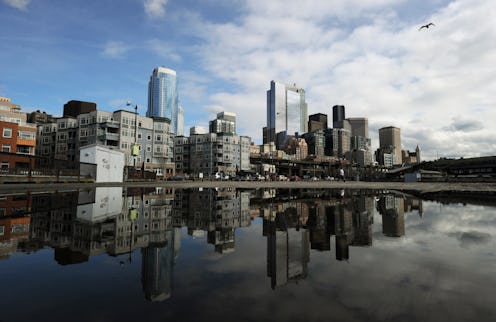News
Could A Big Earthquake Hit The Pacific Northwest?
If you've ever lived out west, or anywhere along the Pacific Rim, odds are you're aware of the risk of earthquakes. That's not to say they can't happen in other places across the country, to be sure, but out here we tend to hear a lot about them, and feel more than our fair share of subterranean rumblings. But even so, a major story in the upcoming July 20 issue of The New Yorker has caught a ton of attention lately, because it's pretty harrowing — will a huge earthquake hit the Pacific Northwest, and what should we do to prepare for it?
According to Kathryn Schultz, the author of the piece titled "The Really Big One," it's essentially a matter of when, not if. Here's the basic idea: there's an enormous fault line known as the Cascadia Subduction Zone, which sits north of the much better known San Andreas fault, running along the coast of the Pacific Northwest for hundreds of miles. Schultz is dead-on when she observes that most Californians only know the name San Andreas — beyond the fact that they even made an anxiety-inducing action film about it, growing up in the Bay Area I've been listening to people prophesy about the fated "Big One" for decades, and it's always centered around that particular fault.
But apparently those concerns are a little misplaced, because the real seismic threat is the Cascadia. Here's how Schultz described the extent of the risk:
In the Pacific Northwest, everything west of Interstate 5 covers some hundred and forty thousand square miles, including Seattle, Tacoma, Portland, Eugene, Salem (the capital city of Oregon), Olympia (the capital of Washington), and some seven million people. When the next full-margin rupture happens ... FEMA projects that nearly thirteen thousand people will die in the Cascadia earthquake and tsunami. Another twenty-seven thousand will be injured, and the agency expects that it will need to provide shelter for a million displaced people, and food and water for another two and a half million.
In other words, precisely the sort of scenario that's been haunting the dreams of scientists and everyday people up and down the west coast for years. It's part of why you can find so many earthquake preparedness PSAs littering the landscape out here — it's an incredibly vulnerable feeling when you have to worry about the ground shaking out from under you, and the amount of friction being built up in the Cascadia is truly worrying.
Here's what can be said, however, as helpfully detailed by Vox: Quakes along the subduction zone happen every 500 to 600 years on average, but the average betrays a lack of consistency. Modern science, for all its marvels, can't yet predict with any reliable precision when an earthquake will happen, sadly, nor can it prevent them — tectonic friction has to be relieved somehow. Developing earthquake early warning systems is a vitally important field, but as Cascadia researcher Evelyn Roeloffs of the U.S. Geological Survey told Vox's Brad Plummer, major advancements in the field could be "many decades of observations" away.
So, sad as it is to say, the most you can do in the here and now is to be prepared, know the risks, and keep your fingers crossed. FEMA has a helpful guide on how to make disaster plans with your family, friends and loved ones, and even though this might all seem like a remote situation, there's never a bad time to get prepared.
Image: Getty Images
